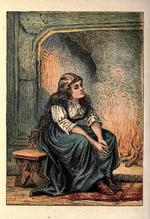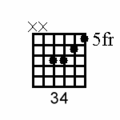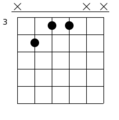This is an old revision of this page, as edited by Kiefer.Wolfowitz (talk | contribs) at 22:15, 1 November 2012 (→Gauges for strings: refs). The present address (URL) is a permanent link to this revision, which may differ significantly from the current revision.
Revision as of 22:15, 1 November 2012 by Kiefer.Wolfowitz (talk | contribs) (→Gauges for strings: refs)(diff) ← Previous revision | Latest revision (diff) | Newer revision → (diff)|
Major thirds tuning is currently a Music good article nominee. Nominated by Kiefer.Wolfowitz at 10:35, 5 September 2012 (UTC) An editor has indicated a willingness to review the article in accordance with the good article criteria and will decide whether or not to list it as a good article. Comments are welcome from any editor who has not nominated or contributed significantly to this article. This review will be closed by the first reviewer. To add comments to this review, click discuss review and edit the page.
|
| Guitarists B‑class | |||||||
| |||||||
| Music theory B‑class Low‑importance | ||||||||||
| ||||||||||
A fact from Major thirds tuning appeared on Misplaced Pages's Main Page in the Did you know column on 30 June 2012 (check views). The text of the entry was as follows:
|
Requested move
- The following discussion is an archived discussion of a requested move. Please do not modify it. Subsequent comments should be made in a new section on the talk page. No further edits should be made to this section.
The result of the move request was: Moved early per primary editor's request. SarekOfVulcan (talk) 03:41, 19 June 2012 (UTC)
All-thirds tuning → Major thirds tuning – No source in the article uses "all-thirds" as a description for the tuning. --SarekOfVulcan (talk) 15:34, 14 June 2012 (UTC)
- Seems like a good idea. All-thirds tuning was named to be similar with the NPOV all-fourths, all-fifths tuning (not perfect fourths and fifths). However, since there is a "minor thirds tuning" (in theory), "all-thirds" could be ambiguous. Kiefer.Wolfowitz 21:30, 14 June 2012 (UTC)
- The above discussion is preserved as an archive of a requested move. Please do not modify it. Subsequent comments should be made in a new section on this talk page. No further edits should be made to this section.
Template:Did you know nominations/Major thirds tuning
The DYK nomination still needs to be reviewed.
Thanks! Kiefer.Wolfowitz 17:11, 25 June 2012 (UTC)
- Thanks to the reviewers. The hook appeared, and is recorded at the top of this page. Kiefer.Wolfowitz 12:16, 24 July 2012 (UTC)
"Major thirds tuning" or "Major-thirds tuning"?
The article is titled "major third tuning" but the introduction reads "major-thirds tuning". Which one should it be? Hyacinth (talk) 09:43, 24 July 2012 (UTC)
- Major-thirds tuning > major thirds tuning
- The adjective "major" modifies the noun "thirds". The modifier "major-third" modifies "tuning". WP:MOS and standard English suggest that the hyphen prevents ambiguity, particularly the mis-reading that "major" and "thirds" separately modify the noun "tuning".
- I assume that Sarek chose the non-hyphenated form for simplicity. Kiefer.Wolfowitz 12:16, 24 July 2012 (UTC)
Chord diagrams
I'm going to deposit some files from the Wikimedia foundation here. These can be used for major-thirds exposition. My labeling assumes the (low)
- C-E-G♯-c-e-g♯
tuning, to avoid the D#.
Would that some angel redraw them for consistency! Kiefer.Wolfowitz 00:20, 20 August 2012 (UTC)
Thanks Kiefer for your comment on my page, you encouraged me to lift it up a bit! I deposited 2 files as requested:
I used TuxGuitar to create them. Cheers --Alexandre Oberlin (talk) 13:08, 23 August 2012 (UTC)
- Thank you very much Alexandre!
- You really drew great diagrams. Every line adds information, and the proportions increase visibility. You also have avoided adding labels to the diagrams, which follows recommended practice at Misplaced Pages, and so allows the diagrams to be reused for chords on many more tunings!
- Trying TuxGuitar, I could create a diagram of the score (including the unwanted staff/stave). How do I export just the chord-diagram?
- It would be great to add a reference to your website in the text (rather than merely in the see also section): Let me know if any academics or music magazines etc. refer to your website, please. (A reliable source citing a website increases its reliability.) If you have an academic connection, or write in refereed publications, then of course your site would be reliable, also. To avoid being declared nonreliable (along with Wikopedia), it is best not to cite Misplaced Pages as a reference, but only list it as suggested further reading.
- Best regards, Kiefer.Wolfowitz 13:58, 23 August 2012 (UTC)
- Hi Kiefer,
- I cropped 1x1 pixels to remove lines top and left so that the diagrams appear clean on white background. I also reset the graphic’s page information to ease further edition on it (I use ImageMagick).
- I just composed the chords in TuxGuitar in Beat / Chord / Insert chord and manually cropped the screenshot.
- For the referrers, I’ll watch ;-)
- Cheers,
- --Alexandre Oberlin (talk) 09:27, 24 August 2012 (UTC)
LaTeX and PDF
- Hi Alexandre!
- That explains my difficulties. I had hoped that it would be less work. I shall look at ImageMagick! :)
I shall look around for LaTeX resources, also.For editors fluent in LaTeX, the gchords package enables the one-line typsetting of guitar chord-diagrams in the form of pdf files. (I recommend the TexMakerX package.)- (I reformatted your response. I'd be happy to undo this reformatting if you like.)
- Thanks again! Kiefer.Wolfowitz 10:59, 24 August 2012 (UTC)
It is possible to import images form pdf files. I quote from Misplaced Pages's tutorial on images:

Images can be excerpted from ... PDF files, with an optional page parameter. For example:
]
Thus, it seems simplest for me to create one PDF file with the images alone on individual pages. Kiefer.Wolfowitz 13:56, 25 August 2012 (UTC)
Kiefer.Wolfowitz 00:05, 26 August 2012 (UTC)
GIMP
It was easy to export snapshots from PDF to PNG format, using the open-source GIMP software. Kiefer.Wolfowitz 17:26, 26 August 2012 (UTC)
Gauges for strings
I record suggested string gauges, two by reliable sources (and one by me, trivial calculating the correct tensions for my Ovation's recommendations for lightest strings). I also list gauges from commercial sources, which are reliable for their gauges.
| Open-note | G♯=A♭ | E | C | G♯=A♭ | E | C | G♯=A♭ | E |
|---|---|---|---|---|---|---|---|---|
| M3 Ralph Patt | .007-8 | .010 | .013p | .022w | .026w | .032w | .042w | .052 |
| M3 Ole Kirkeby (round wound) | .010p | .013p | .020w | .028w | .036w | .044w | .052w | |
| M3 KW (Light, 25.25 in.) | .008-9 | .010p | .0135p | .022w | .028w | .035w | .044w | .055-6w |
| Gypsy light | .010p | .014p | .023w | .026w | .034w | .044w | ||
| Gypsy medium | .011p | .015p | .024w | .028w | .035w | .045w | ||
| Open-G DBG-DBG-D | D | B | G | D | B | G | D | |
| Russian 7-string | .012 | .014 | .019 | .024 | .030 | .039 | .051 |
Can anybody explain why "Gypsy strings" (from e.g. D'Addario) suit major-thirds tuning? (Also an influence on gypsy music, the Russian guitar's tuning is major-thirds "on average", and so I list its gauges.) Kiefer.Wolfowitz 22:13, 1 November 2012 (UTC)
- ^ D'Addario
- Elixer Nanoweb, e.g. Custom Lights
- ^ Cite error: The named reference
ENwas invoked but never defined (see the help page).






